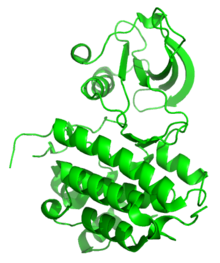| Eph receptor ligand binding domain | |||||||||
|---|---|---|---|---|---|---|---|---|---|
 Structure of the kinase domain of human eph type-A receptor 5 (EphA5) | |||||||||
| Identifiers | |||||||||
| Symbol | Ephrin_lbd | ||||||||
| Pfam | PF01404 | ||||||||
| InterPro | IPR016257 | ||||||||
| SCOP2 | 1nuk / SCOPe / SUPFAM | ||||||||
| CDD | cd10319 | ||||||||
| Membranome | 1202 | ||||||||
| |||||||||
Eph receptors (Ephs, after erythropoietin-producing human hepatocellular receptors) are a group of receptors that are activated in response to binding with Eph receptor-interacting proteins (Ephrins). Ephs form the largest known subfamily of receptor tyrosine kinases (RTKs). Both Eph receptors and their corresponding ephrin ligands are membrane-bound proteins that require direct cell-cell interactions for Eph receptor activation. Eph/ephrin signaling has been implicated in the regulation of a host of processes critical to embryonic development including axon guidance,[1] formation of tissue boundaries,[2] cell migration, and segmentation.[3] Additionally, Eph/ephrin signaling has been identified to play a critical role in the maintenance of several processes during adulthood including long-term potentiation,[4] angiogenesis,[5] and stem cell differentiation and cancer.[6]
- ^ Egea J, Klein R (May 2007). "Bidirectional Eph-ephrin signaling during axon guidance". Trends Cell Biol. 17 (5): 230–8. doi:10.1016/j.tcb.2007.03.004. PMID 17420126.
- ^ Rohani N, Canty L, Luu O, Fagotto F, Winklbauer R (March 2011). Hamada H (ed.). "EphrinB/EphB signaling controls embryonic germ layer separation by contact-induced cell detachment". PLOS Biol. 9 (3): e1000597. doi:10.1371/journal.pbio.1000597. PMC 3046958. PMID 21390298.
- ^ Davy A, Soriano P (January 2005). "Ephrin signaling in vivo: look both ways". Dev. Dyn. 232 (1): 1–10. doi:10.1002/dvdy.20200. PMID 15580616. S2CID 37808863.
- ^ Kullander K, Klein R (July 2002). "Mechanisms and functions of Eph and ephrin signalling". Nat. Rev. Mol. Cell Biol. 3 (7): 475–86. doi:10.1038/nrm856. PMID 12094214. S2CID 1735440.
- ^ Kuijper S, Turner CJ, Adams RH (July 2007). "Regulation of angiogenesis by Eph-ephrin interactions". Trends Cardiovasc. Med. 17 (5): 145–51. doi:10.1016/j.tcm.2007.03.003. PMID 17574121.
- ^ Genander M, Frisén J (October 2010). "Ephrins and Eph receptors in stem cells and cancer". Curr. Opin. Cell Biol. 22 (5): 611–6. doi:10.1016/j.ceb.2010.08.005. PMID 20810264.